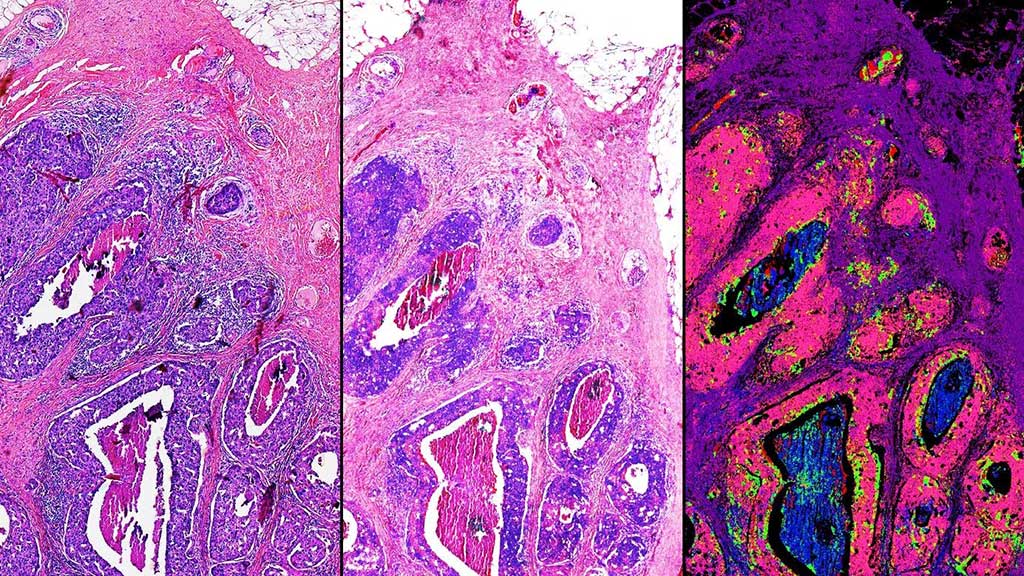All-Digital Histopathology Attained by Infrared-Optical Hybrid Microscopy
By LabMedica International staff writers
Posted on 24 Feb 2020
The gold standard of tissue pathology is to add dyes or stains so that pathologists can see the shapes and patterns of the cells under a microscope. However, it can be difficult to distinguish cancer from healthy tissue or to pinpoint the boundaries of a tumor, and in many cases diagnosis is subjective.Posted on 24 Feb 2020
Optical microscopy for biomedical samples requires expertise in histological staining to visualize structure and composition. Mid-infrared (mid-IR) spectroscopic imaging offers label-free molecular recording and virtual staining by probing fundamental vibrational modes of molecular components.

Image: This side-by-side comparison of a breast tissue biopsy demonstrates some of the infrared-optical hybrid microscope’s capabilities. On the left, a tissue sample dyed by traditional methods. Center, a computed stain created from infrared-optical hybrid imaging. Right, tissue types identified with infrared data. The pink in this image signifies malignant cancer (Photo courtesy of Rohit Bhargava, PhD).
Bioengineers at the University of Illinois at Urbana–Champaign (Urbana, IL, USA) and their colleagues developed a hybrid microscope by adding an infrared laser and a specialized microscope lens, called an interference objective, to an optical camera. The infrared-optical hybrid measures both infrared data and a high-resolution optical image with a light microscope, the kind ubiquitous in clinics and laboratories.
The team combined the two techniques which harnesses the strengths of both. It has the high resolution, large field-of-view and accessibility of an optical microscope. Furthermore, infrared data can be analyzed computationally, without adding any dyes or stains that can damage tissues. Software can recreate different stains or even overlap them to create a more complete, all-digital picture of what is in the tissue.
The scientists verified their microscope by imaging breast tissue samples, both healthy and cancerous, and comparing the results of the hybrid microscope's computed "dyes" with those from the traditional staining technique. The digital biopsy closely correlated with the traditional one. Furthermore, they found that their infrared-optical hybrid outperformed state-of-the-art in infrared microscopes in several ways. It has 10 times larger coverage, greater consistency and four times higher resolution, allowing infrared imaging of larger samples, in less time, with unprecedented detail.
Rohit Bhargava, PhD, a Professor of Bioengineering and senior author of the study, said, “The advantage is that no stains are required, and both the organization of cells and their chemistry can be measured. Measuring the chemistry of tumor cells and their microenvironment can lead to better cancer diagnoses and better understanding of the disease.”
The authors concluded that infrared-optical hybrid (IR-OH) is compatible with clinical pathology practice and could make for a cost-effective alternative to conventional stain-based protocols for stainless, all-digital pathology. The study was published on February 3, 2020 in the Proceedings of the National Academy of Sciences.
Related Links:
University of Illinois at Urbana – Champaign













